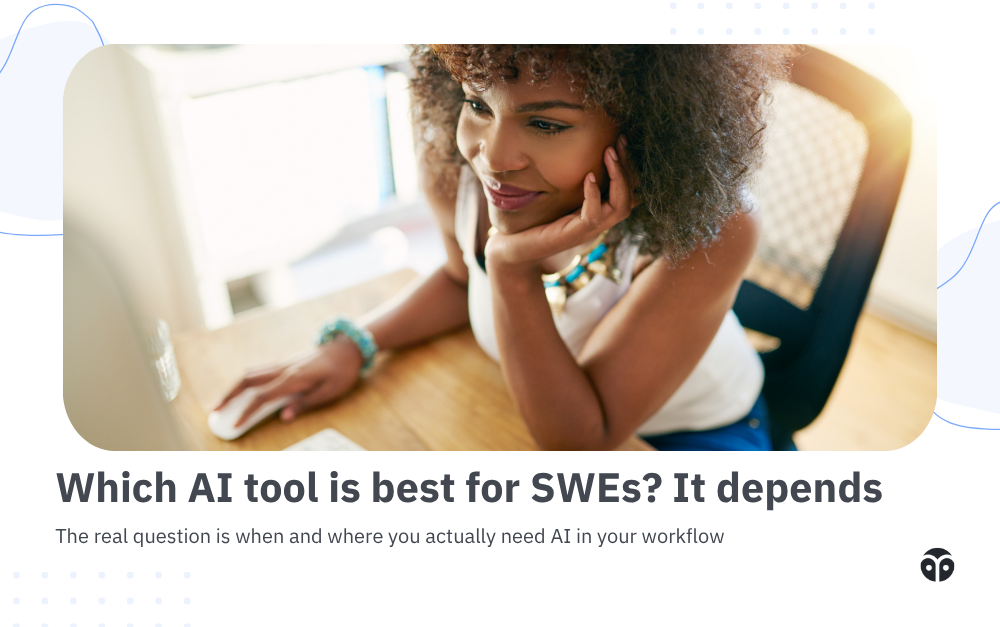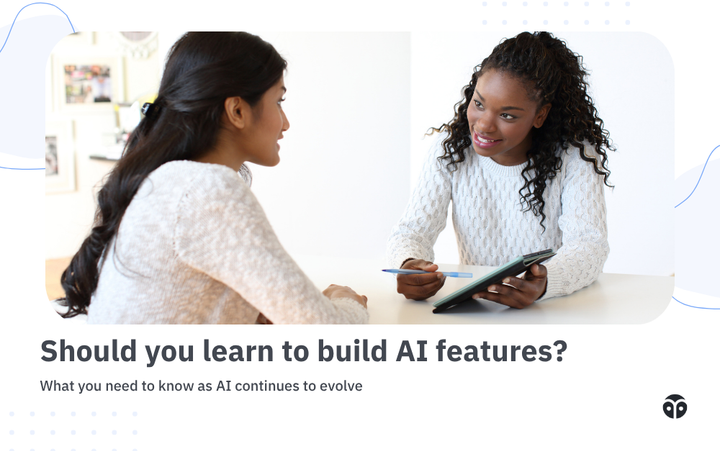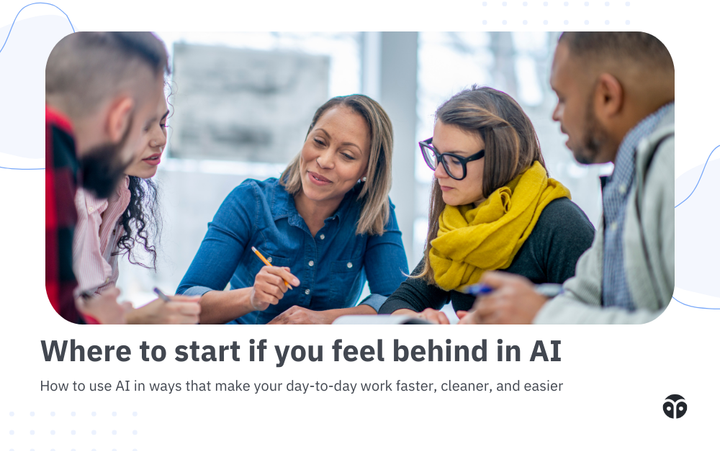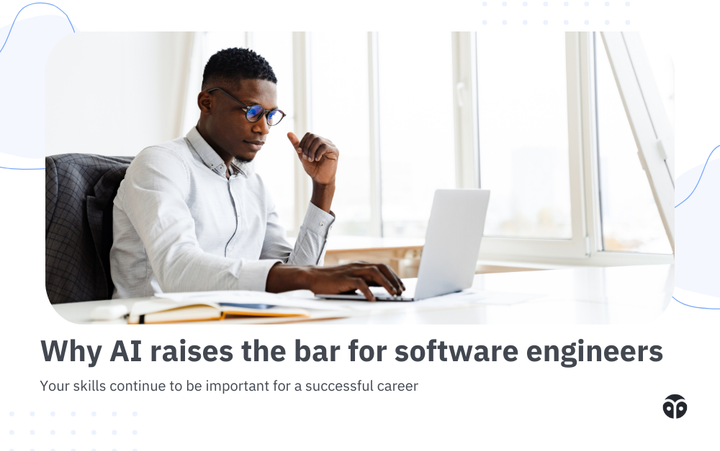Which AI tool is best for software engineers? It depends
Learn what AI tools are best for software engineering teams (the answer isn't what you think).

Engineering teams aren’t exactly begging for more AI tools. But across tech, there’s a growing push from leadership: Use more AI. Speed things up. Make it work. And for many engineers, that’s the starting point — not a clean slate of tooling options or a greenfield moment to explore what’s possible.
People are under pressure to adopt AI, but are unsure where to begin. They might only have access to a narrow set of tools, or they might be forced to use a model that’s clearly not right for the task. It’s not that they don’t want to use AI, it’s that they’re handed the “how” before they ever had a chance to explore the “why.”
So instead of asking, What’s the best AI tool for developers?, a better question might be: Where in the work could this tool actually help?
That’s the shift that unlocks real adoption, not a hunt for the best product, but a focus on actual workflow friction. Because if you’re stuck with one tool or model, the smartest move is learning how to make it work where it matters most.
Adoption starts where the pain is
Ask any engineering team what AI tools they’re using, and you’ll get the usual suspects: Copilot, Devin, Cody, etc. Ask which is best and you’ll likely get a shrug, a rant, or a debate.
It sounds like the right place to start. But for most teams, it’s the wrong question.
With the surge of AI tools for coding, it’s tempting to believe that success lies in picking the best one. Find the most advanced model, roll it out to the team, and wait for velocity to improve.
But the reality is more nuanced. AI adoption in engineering teams rarely begins with tool comparisons or product demos. It begins with workflow friction — moments when the job gets harder than it should be, and a tool can offer relief.
When AI tools are helpful in these real, everyday moments, they get used. The best AI tool for coding isn’t the one with the longest capabilities list. It’s the one that quietly removes friction from the work that’s already happening.
It’s also why so many team-wide AI rollouts fizzle. If you lead with tooling but skip over context, you end up solving a problem that no one feels.
The right tool is the one that helps with the job in front of you
Even if your team only has access to one model, you still get to decide how to use it. Instead of asking which AI assistant is best in a vacuum, focus on the task at hand:
- If you're writing boilerplate tests for the third time this week, the best tool is the one that fills in the blanks.
- If you're lost in a legacy codebase, it’s the one that can answer: “Where does this value come from?”
- If you’re refactoring something tedious, it's the one that saves you from retyping the same five patterns.
Great AI tools don’t ask you to change how you work. They meet you in the moment you need help. That’s what separates an assistant from a distraction.
Even retrieval-based tools that understand your repo only shine when the task calls for it. A slow model with mediocre autocomplete may still be useful in the right task. A fancy one may not matter at all if it doesn’t plug into the dev environment where you’re doing the work.
The best AI tools for developers depends on the workflow
The question “What’s the best AI tool for developers?” has no single answer. The right tool depends on what you’re trying to do, where you’re doing it, and how well the tool fits your flow.
The “best” AI tool depends less on what it does and more on what you need.
- If you’re debugging a legacy system on a Friday afternoon and your brain is mush, the best tool is the one that helps you think again.
- If you’re writing integration tests for the third microservice this week, the best tool is the one that fills in the boring parts so you don’t have to.
- If you’re ramping into a messy codebase, it’s the one that can answer “Wait, where does this value even come from?”
Adoption should be contextual, not generic. Great AI tools don’t ask you to change how you work. They meet you where the work is already happening. If you’re deep in a codebase and don’t want to tab out, Copilot showing up right at your cursor is magic. If you’re context-switching between files and memory is fuzzy, retrieval-based tools that understand your repo are gold.
But if the tool needs its own tab, new habits, or a half-hour of setup before it helps… good luck. Most SWEs will try anything once. But if it doesn't fit into flow, it won’t last past the experiment.
How engineering teams can adopt AI effectively
For engineering leaders thinking about AI adoption, ask:
- Where in our development process are engineers losing time?
- What’s slowing them down, and what kind of help would meaningfully speed them up?
- Are we giving the team low-stakes ways to try these tools in moments that matter?
Many successful teams start small. Try a shared Slack thread where engineers post useful prompts and ideas, or a weekly demo showing how someone used an AI assistant to fix a real bug. Some teams rework documentation to include “how to use AI here” in onboarding guides or internal wikis.
Fluency builds when engineers discover, in their own workflows, where the tool actually helps.
AI tools don’t replace engineering judgment
AI coding tools are not managing cross-functional dependencies, reasoning about tradeoffs, or deciding how to structure teams and services.
But it is shaving minutes (and sometimes hours) off things you already know how to do.
And those minutes add up.
The real value of AI for software engineers lies in reducing drag. It’s in helping people move through familiar problems with less effort so they can spend more time where judgment, creativity, and human context are still irreplaceable.
Reframe the question to make adoption meaningful
So if you’re thinking about AI adoption, don’t ask, “What’s the best AI tool for coding?”Instead, ask, “Where in the work are we getting stuck?”
Because once you find the moment, the right tool is easy to spot. And once the tool proves helpful in one workflow, the rest often follows.
That’s how real adoption starts.
Learn how to level up with AI
If you're exploring how to use AI more effectively in your work, you're not alone. That’s why we built Ship with AI — a program for senior engineers who want to work more efficiently and improve their skills, with AI as a collaborator.
Learn more and apply here.



